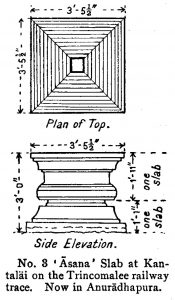OB03085 Kantaläi Gal-Āsana Inscription of Kitti Nissaṅka-Malla
Diagram of the Kantaläi gal-āsana. Published in: Wickremasinghe, Don Martino de Zilva. (1912-27). ‘No. 42. (Reg. No. 3.) Kantaläi Gal-Āsana Inscription of Kitti Nissaṅka-Malla (1187–1196 A.D.),’ Epigraphia Zeylanica 2, p. 283.
IN03105 Kantaläi Gal-Āsana Inscription of Kitti Nissaṅka-Malla
The inscription is engraved around the four sides of a stone seat (gal–āsana), which was discovered in 1921 in the village of Kantaläi on the Trincomalee Railway and afterwards removed to Anurādhapura. The text identifies the stone seat as the one that king Nissaṅka-Malla, after returning from his Indian campaign, used to occupy whilst witnessing the various diversions such as alms-giving, dancing, singing, etc., in the Pārvatī-satra erected at his request in Caturveda-Brahmapura, ‘the city of the Four-Vedic Brahmans’. By way of an introduction, the inscription also includes a bombastic account of Nissaṅka-Malla’s military achievements and charitable acts. Virtually identical accounts are commonly found in other gal-āsana records of this king. The Kantaläi inscription is not dated but, since it references his tours of inspection and his expedition to India, it was probably composed towards the end of his short but eventful reign, which spanned nine years, beginning in 1187 and terminating in 1196. If Kantaläi was the original site of the seat, then this locality must once have been the town called Caturveda-Brahmapura, which was probably occupied mostly by Brahman families for whose benefit an almshouse called Brāhmaṇa-satra was also established by Nissaṅka-Malla.
